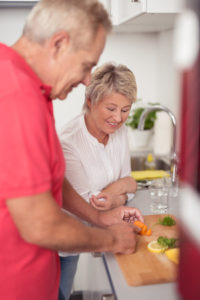 There seems to be a lot of media stories in recent years about food safety. While many of us think we are up to snuff on best practices in the kitchen, it never hurts to have a refresher course.
There seems to be a lot of media stories in recent years about food safety. While many of us think we are up to snuff on best practices in the kitchen, it never hurts to have a refresher course.
EatRight.com, the website of the Academy of Nutrition and Dietetics, offers wonderful information and guidelines for minimizing your risk of getting food poisoning. Their website reports that each year food poisoning affects one in six Americans. Twenty-five percent of those sickened represent vulnerable populations: older adults, children and pregnant women.
Older adults are more at risk because our immune system grows weaker as we age. Adding to the immunity factor is the inconsistency of older adults in properly handling food, according to the Food and Drug Administration. To help counter this trend, EatRight.com offers tips specifically geared towards seniors:
- If you have eye glasses, be sure and wear them when preparing and handling food. This helps ensure you read labels accurately and can identify foods that look spoiled.
- Turn up the lights.
- Use a black marker to label perishable food with the purchase date.
- Save your energy for cleanup by cooking simple dishes and buying pre-chopped, frozen vegetables.
- Don’t rely on sight and smell to determine if food is safe. Use a food thermometer to make sure meats, poultry and egg dishes are cooked until done. Also check the shelf life of leftovers using the Keep it Cool Chart.
- Set up a support system of family and friends to help with kitchen tasks when you’re low on energy.
- Reheat hot dogs, lunch meat, and fermented and dry sausage until steaming hot. These items, while pre-cooked, may become infected during processing and packaging.
Proper food preparation is also essential to ensuring foods are bacteria-free:
- Wash hands with soap and warm water for at least 20 seconds. Do this during and after food prep.
- Rinse all produce, including the ones with inedible skins, like bananas and oranges. Scrub firm-skin produce, like apples and cucumbers, under running water.
- Clean the lids of canned food before opening.
- Clean all surfaces, including counter top, refrigerator and microwave.
How you store food is every bit as critical to food safety as cooking and handling. Here are EatRight.com tips for best practices in that area:
- Refrigerate food within two hours of cooking or purchasing (or one hour if the temperature is 90+degrees) to slow the growth of bacteria.
- Store leftovers in covered containers that are 2” deep or less and eat the food within 3-4 days.
- Use a thermometer to ensure the refrigerator is at or below 40° F and the freezer is at or below zero° F.
If you’d like a food “cheat sheet” that’s easy to consult, you can download the “Is My Food Safe?” app on Google Play and the iPhone App Store. The app is a free service of the Home Food Safety program, a collaborative effort between the Academy of Nutrition and Dietetics and ConAgra Foods.